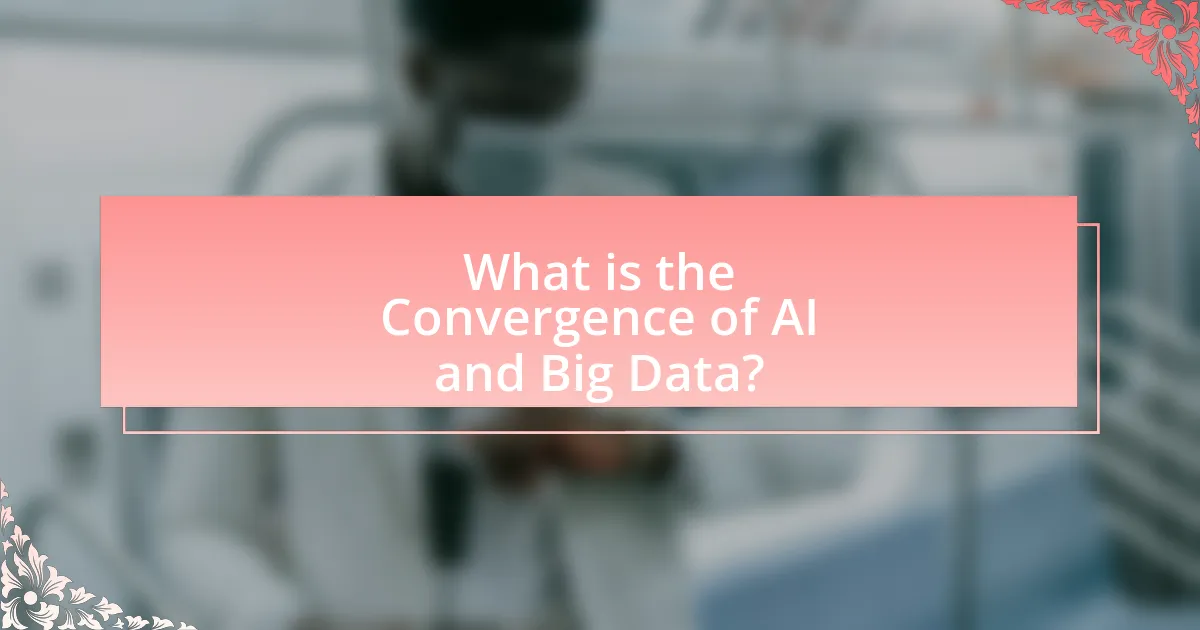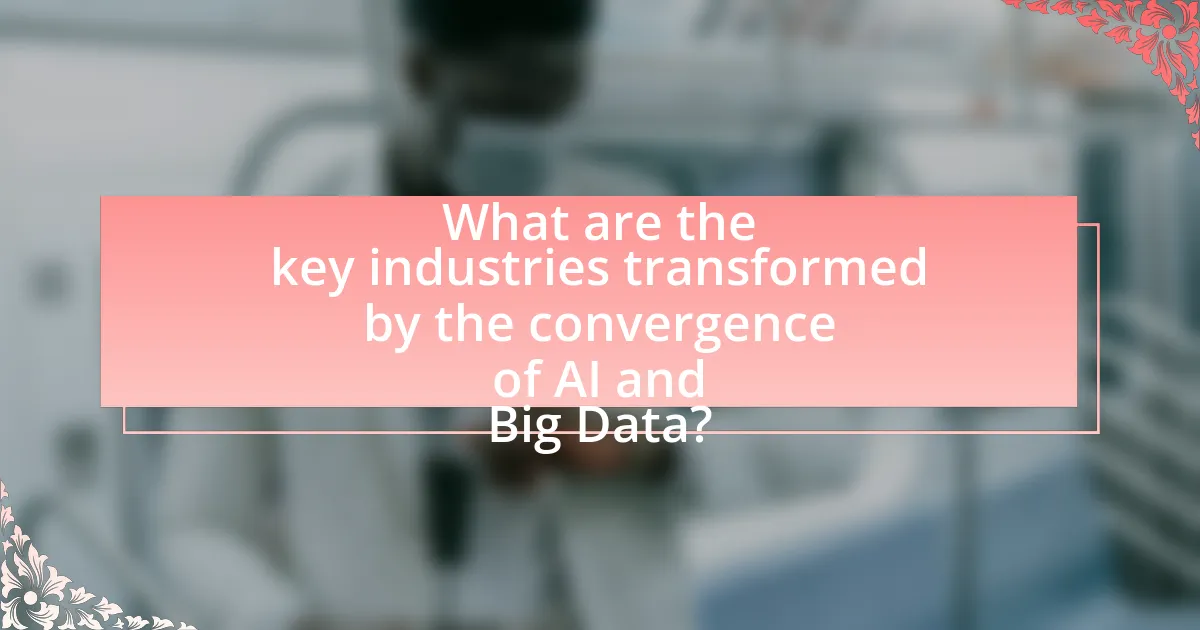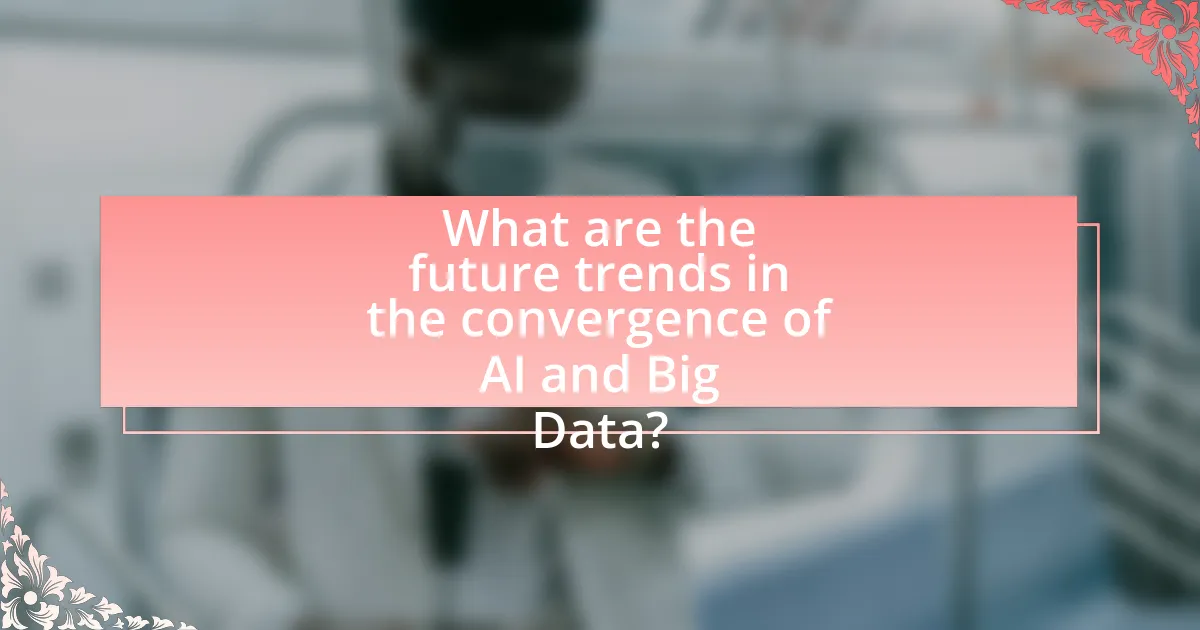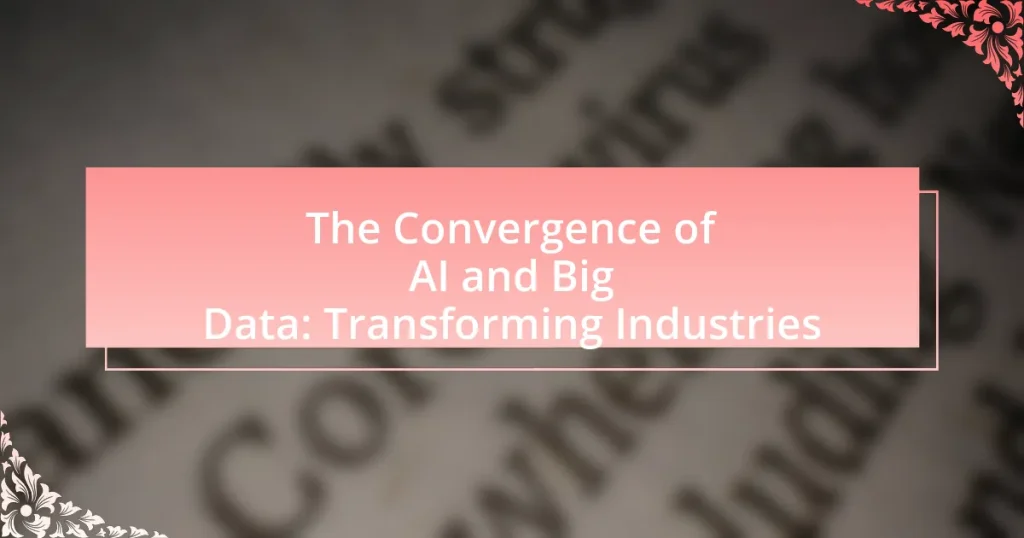The convergence of artificial intelligence (AI) and big data represents a transformative integration that enhances data analysis, decision-making, and predictive capabilities across various industries. This article explores how AI and big data interact, the key technologies facilitating their convergence, and the significant benefits organizations can achieve, such as increased profitability and operational efficiency. It also addresses the challenges faced by industries lacking this integration and highlights specific applications in sectors like healthcare and finance. Furthermore, the article discusses future trends, best practices for successful integration, and strategies to ensure data quality and collaboration between data scientists and business leaders.

What is the Convergence of AI and Big Data?
The convergence of AI and Big Data refers to the integration of artificial intelligence technologies with large datasets to enhance data analysis, decision-making, and predictive capabilities. This synergy allows organizations to extract valuable insights from vast amounts of data, enabling more accurate predictions and personalized experiences. For instance, according to a report by McKinsey, companies that effectively leverage AI and Big Data can increase their profitability by up to 30%. This demonstrates the significant impact of their convergence on business performance and innovation across various industries.
How do AI and Big Data interact with each other?
AI and Big Data interact by leveraging large datasets to enhance machine learning algorithms and improve decision-making processes. Big Data provides the vast amounts of structured and unstructured data necessary for AI systems to learn patterns, make predictions, and generate insights. For instance, according to a report by McKinsey, companies that effectively utilize Big Data and AI can increase their operating margins by more than 60%. This synergy allows businesses to optimize operations, personalize customer experiences, and drive innovation across various industries.
What are the key technologies that facilitate this convergence?
The key technologies that facilitate the convergence of AI and Big Data include machine learning algorithms, data analytics platforms, cloud computing, and natural language processing. Machine learning algorithms enable systems to learn from large datasets, improving predictive accuracy and decision-making. Data analytics platforms, such as Apache Hadoop and Spark, process vast amounts of data efficiently, allowing for real-time insights. Cloud computing provides scalable resources for storing and processing big data, making it accessible for AI applications. Natural language processing allows machines to understand and interpret human language, enhancing user interaction with data-driven AI systems. These technologies collectively drive innovation across various industries by enabling smarter data utilization and automation.
How does the integration of AI enhance Big Data analytics?
The integration of AI enhances Big Data analytics by enabling more efficient data processing and deeper insights through advanced algorithms. AI technologies, such as machine learning and natural language processing, allow for the automation of data analysis, significantly reducing the time required to extract valuable information from large datasets. For instance, AI can identify patterns and trends that may not be immediately apparent to human analysts, leading to more accurate predictions and informed decision-making. According to a report by McKinsey, organizations that leverage AI in their analytics processes can improve their productivity by up to 40%, demonstrating the substantial impact of AI on enhancing the capabilities of Big Data analytics.
Why is the convergence of AI and Big Data important?
The convergence of AI and Big Data is important because it enhances decision-making and operational efficiency across various industries. By integrating AI algorithms with vast datasets, organizations can uncover insights, predict trends, and automate processes. For instance, a study by McKinsey & Company found that companies leveraging AI and Big Data can improve their productivity by up to 40%. This synergy enables businesses to tailor products and services to customer needs, optimize supply chains, and drive innovation, ultimately leading to competitive advantages in the market.
What challenges do industries face without this convergence?
Industries face significant challenges without the convergence of AI and Big Data, primarily in data analysis and decision-making efficiency. Without this integration, organizations struggle to process vast amounts of data quickly, leading to slower insights and delayed responses to market changes. For instance, a McKinsey report indicates that companies leveraging AI and Big Data can improve their decision-making speed by up to 5 times compared to those that do not. Additionally, without convergence, industries may experience increased operational costs due to inefficient processes and missed opportunities for automation, which AI can facilitate. This lack of synergy also hampers innovation, as companies are unable to harness predictive analytics effectively, limiting their ability to anticipate customer needs and market trends.
How does this convergence drive innovation across sectors?
The convergence of AI and Big Data drives innovation across sectors by enabling data-driven decision-making and enhancing operational efficiency. This integration allows organizations to analyze vast amounts of data in real-time, leading to improved insights and faster responses to market changes. For instance, in healthcare, AI algorithms analyze patient data to predict disease outbreaks, which can lead to timely interventions and better patient outcomes. Similarly, in retail, companies utilize AI to personalize customer experiences based on purchasing patterns derived from Big Data analytics, resulting in increased sales and customer loyalty. This synergy not only fosters innovation but also creates competitive advantages across various industries.

What are the key industries transformed by the convergence of AI and Big Data?
The key industries transformed by the convergence of AI and Big Data include healthcare, finance, retail, manufacturing, and transportation. In healthcare, AI and Big Data enable predictive analytics for patient outcomes and personalized medicine, improving treatment efficacy. In finance, these technologies enhance fraud detection and risk management through real-time data analysis. Retail benefits from AI-driven customer insights and inventory optimization, leading to improved sales strategies. Manufacturing utilizes AI and Big Data for predictive maintenance and supply chain optimization, increasing operational efficiency. Transportation leverages these technologies for route optimization and autonomous vehicle development, enhancing safety and efficiency. Each of these industries demonstrates significant advancements and operational improvements due to the integration of AI and Big Data.
How is healthcare benefiting from AI and Big Data integration?
Healthcare is benefiting from AI and Big Data integration through enhanced diagnostic accuracy and personalized treatment plans. AI algorithms analyze vast datasets, including patient records and medical imaging, to identify patterns that improve disease detection rates. For instance, a study published in the journal Nature found that AI systems can diagnose certain cancers with an accuracy of up to 94%, significantly higher than traditional methods. Additionally, Big Data analytics enables healthcare providers to tailor treatments based on individual patient data, leading to improved outcomes and reduced costs. According to a report by McKinsey, personalized medicine could save the U.S. healthcare system up to $450 billion annually by optimizing treatment strategies.
What specific applications of AI and Big Data are revolutionizing patient care?
AI and Big Data are revolutionizing patient care through applications such as predictive analytics, personalized medicine, and telemedicine. Predictive analytics utilizes algorithms to analyze vast datasets, enabling healthcare providers to anticipate patient outcomes and improve treatment plans; for instance, studies show that predictive models can reduce hospital readmission rates by up to 20%. Personalized medicine leverages genetic information and health data to tailor treatments to individual patients, enhancing efficacy and minimizing side effects; research indicates that targeted therapies can increase treatment success rates significantly. Telemedicine platforms, powered by AI, facilitate remote consultations and monitoring, improving access to care and patient engagement; data from the American Telemedicine Association reveals that telehealth usage surged by over 154% during the COVID-19 pandemic, demonstrating its critical role in modern healthcare delivery.
How does data-driven decision-making improve healthcare outcomes?
Data-driven decision-making improves healthcare outcomes by enabling precise, evidence-based interventions tailored to individual patient needs. This approach utilizes vast amounts of patient data, including electronic health records and clinical studies, to identify trends, predict outcomes, and optimize treatment plans. For instance, a study published in the Journal of the American Medical Association found that hospitals employing data analytics reduced readmission rates by 20% through targeted follow-up care. By leveraging data, healthcare providers can enhance patient safety, streamline operations, and ultimately improve overall health outcomes.
In what ways is the finance sector leveraging AI and Big Data?
The finance sector is leveraging AI and Big Data primarily through enhanced risk assessment, fraud detection, personalized customer experiences, and algorithmic trading. Financial institutions utilize AI algorithms to analyze vast datasets, enabling them to identify patterns and predict market trends, which improves decision-making processes. For instance, according to a report by McKinsey, firms that effectively use AI in risk management can reduce losses by up to 20%. Additionally, AI-driven analytics help detect fraudulent activities in real-time, significantly lowering the incidence of financial crimes. Personalized services, powered by Big Data insights, allow banks to tailor products to individual customer needs, increasing customer satisfaction and retention. Furthermore, algorithmic trading systems, which rely on AI and Big Data, execute trades at high speeds and volumes, optimizing investment strategies and enhancing market efficiency.
What role does predictive analytics play in financial services?
Predictive analytics plays a crucial role in financial services by enabling institutions to forecast future trends and behaviors based on historical data. This capability allows banks and financial organizations to enhance risk management, improve customer segmentation, and optimize marketing strategies. For instance, a study by McKinsey & Company found that financial institutions leveraging predictive analytics can reduce credit risk by up to 20% through better assessment of borrower profiles. Additionally, predictive models help in detecting fraudulent activities by analyzing transaction patterns, leading to a significant decrease in financial losses. Thus, the integration of predictive analytics in financial services not only enhances operational efficiency but also drives informed decision-making.
How does AI enhance risk management in finance?
AI enhances risk management in finance by enabling predictive analytics, which allows financial institutions to identify potential risks before they materialize. Through machine learning algorithms, AI analyzes vast datasets to detect patterns and anomalies that human analysts might overlook. For instance, a study by McKinsey & Company found that organizations using AI for risk management can reduce losses by up to 20% through improved fraud detection and credit risk assessment. This capability not only streamlines decision-making processes but also enhances compliance with regulatory requirements, ultimately leading to more resilient financial systems.

What are the future trends in the convergence of AI and Big Data?
Future trends in the convergence of AI and Big Data include enhanced predictive analytics, real-time data processing, and increased automation across industries. Enhanced predictive analytics will leverage AI algorithms to analyze vast datasets, enabling businesses to forecast trends and consumer behavior with greater accuracy. Real-time data processing will allow organizations to make instantaneous decisions based on live data streams, improving operational efficiency. Additionally, increased automation will streamline workflows by integrating AI-driven insights into business processes, reducing human intervention and errors. These trends are supported by the growing adoption of cloud computing and advancements in machine learning technologies, which facilitate the handling of large datasets and complex algorithms.
How will advancements in AI impact Big Data analytics in the coming years?
Advancements in AI will significantly enhance Big Data analytics by improving data processing speed, accuracy, and predictive capabilities. AI algorithms, particularly machine learning models, can analyze vast datasets more efficiently than traditional methods, enabling real-time insights and decision-making. For instance, a study by McKinsey & Company indicates that organizations leveraging AI in their analytics processes can achieve up to 20% higher productivity and 30% faster decision-making. Furthermore, AI can automate data cleaning and preparation, reducing the time analysts spend on these tasks and allowing them to focus on deriving actionable insights. This integration of AI into Big Data analytics will lead to more informed business strategies and improved operational efficiencies across various industries.
What emerging technologies are likely to shape this convergence?
Emerging technologies likely to shape the convergence of AI and Big Data include machine learning, edge computing, and blockchain. Machine learning enhances data analysis capabilities, enabling more accurate predictions and insights from large datasets. Edge computing facilitates real-time data processing closer to the source, reducing latency and improving efficiency in AI applications. Blockchain provides secure and transparent data management, ensuring data integrity and trustworthiness in AI-driven systems. These technologies collectively drive innovation and efficiency across various industries, as evidenced by their increasing adoption in sectors such as healthcare, finance, and manufacturing.
How can businesses prepare for future developments in AI and Big Data?
Businesses can prepare for future developments in AI and Big Data by investing in advanced analytics capabilities and fostering a culture of continuous learning. By adopting tools that leverage machine learning and data analytics, organizations can enhance decision-making processes and improve operational efficiency. For instance, a McKinsey report indicates that companies that utilize AI in their operations can increase their cash flow by 20% to 30% over the next decade. Additionally, businesses should prioritize data governance and ethical AI practices to ensure compliance and build trust with customers. This proactive approach not only positions companies to capitalize on emerging technologies but also mitigates risks associated with data privacy and security.
What best practices should organizations adopt for successful integration?
Organizations should adopt a structured approach to integration by focusing on clear communication, aligning goals, and leveraging technology effectively. Clear communication ensures that all stakeholders understand the integration process, which is crucial for minimizing resistance and fostering collaboration. Aligning goals across departments helps in creating a unified vision, which is essential for successful integration. Leveraging technology, such as data analytics and AI tools, enhances decision-making and streamlines processes, leading to more efficient integration outcomes. According to a study by McKinsey, organizations that prioritize these best practices are 1.5 times more likely to achieve successful integration compared to those that do not.
How can companies ensure data quality and security in AI and Big Data projects?
Companies can ensure data quality and security in AI and Big Data projects by implementing robust data governance frameworks and employing advanced security measures. A strong data governance framework establishes clear policies for data management, ensuring accuracy, consistency, and reliability of data. For instance, organizations can adopt data quality metrics and regular audits to monitor data integrity. Additionally, employing encryption, access controls, and regular security assessments protects sensitive data from breaches. According to a report by McKinsey, companies that prioritize data governance can improve their data quality by up to 30%, significantly enhancing the effectiveness of AI models.
What strategies can enhance collaboration between data scientists and business leaders?
Enhancing collaboration between data scientists and business leaders can be achieved through clear communication, shared goals, and cross-functional teams. Clear communication ensures that both parties understand each other’s objectives and constraints, which fosters a collaborative environment. Establishing shared goals aligns the efforts of data scientists and business leaders, making it easier to work towards common outcomes. Cross-functional teams, which include members from both domains, facilitate knowledge sharing and promote a culture of collaboration. Research by McKinsey & Company indicates that organizations with strong collaboration between data teams and business units are 5 times more likely to make faster decisions, highlighting the effectiveness of these strategies.


